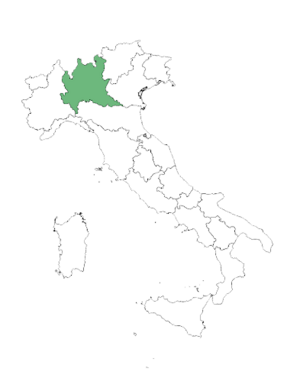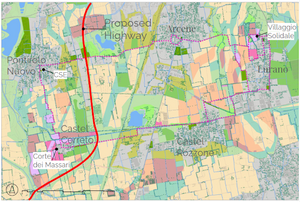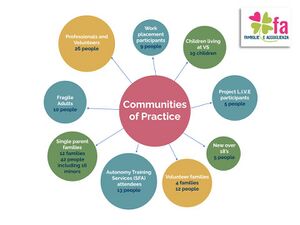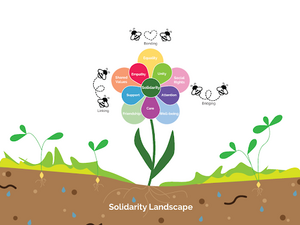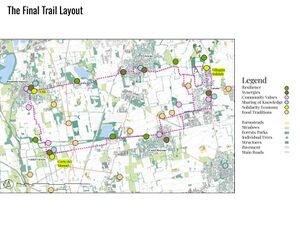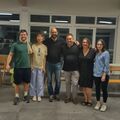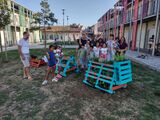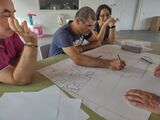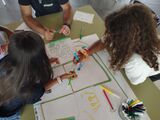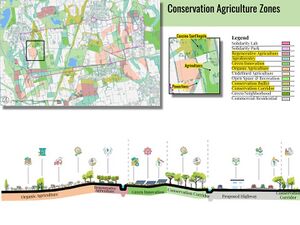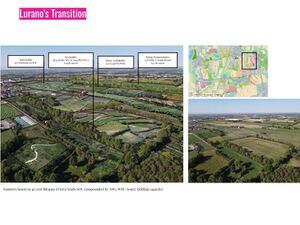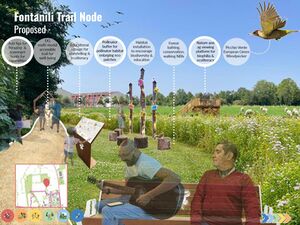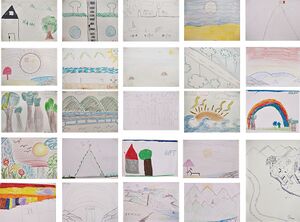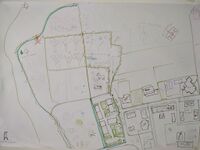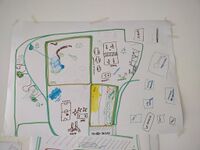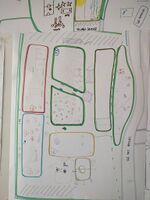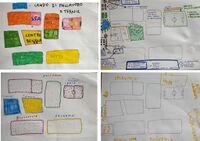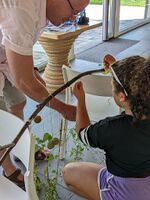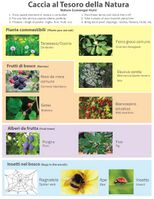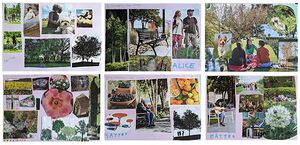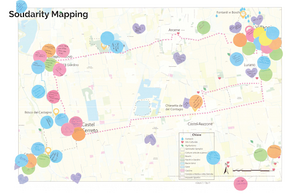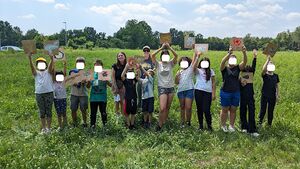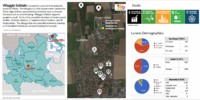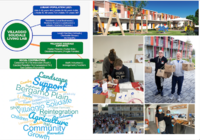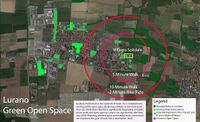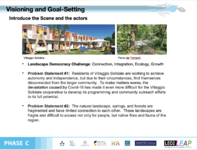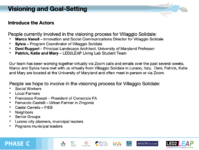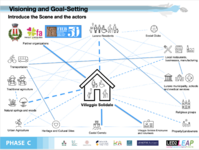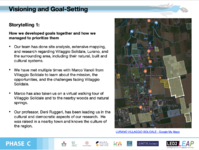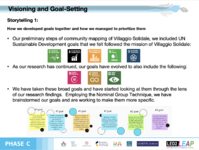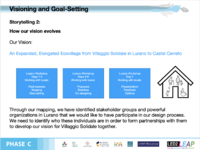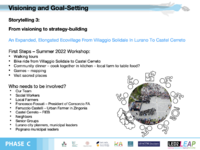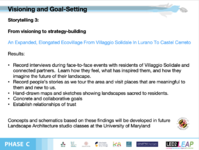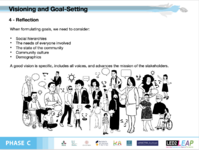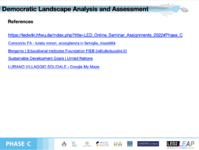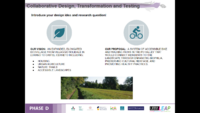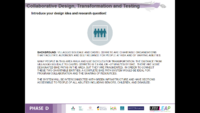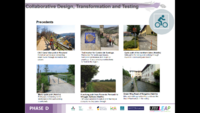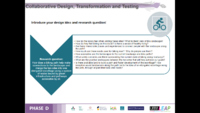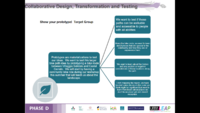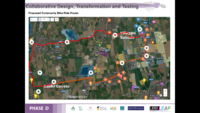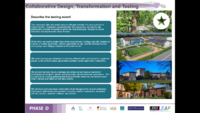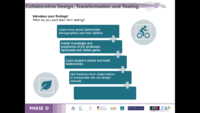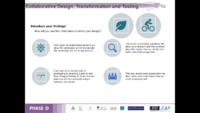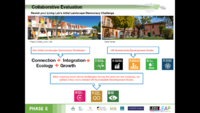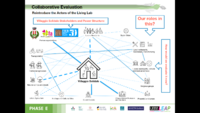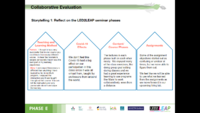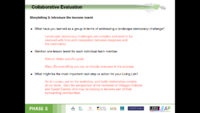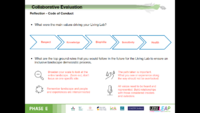Lurano Living Lab
>>>back to working groups overview
For help with editing this Wiki page use this link.
For more details on assignments and key readings please use this link.
| Area | Villaggio Solidale | |
| Place | Lurano | |
| Country | Italy | |
| Topics | Accessibility, Agroecology, Capabilities, Co-Creation, Heritage, Well-being | |
| Author(s) | Mary Christensen, Patrick Boyle | |
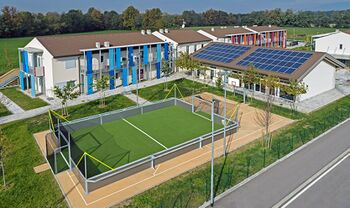
| ||
The Solidarity Landscape Living Lab Background
The Solidarity Landscape Living Lab began in 2022 as a participatory action research project. The project is a collaboration between landscape architecture students and faculty from the University of Maryland and Consorzio FA, a social cooperative in Northern Italy's Bergamo region. Consorzio FA supports vulnerable populations, such as children in foster care, single-parent families, and adults with disabilities through three hubs: Villaggio Solidale, a co-housing community in Lurano; Corte dei Massari, a co-housing community and school for children with autism in Castel Cerreto; and the CSE educational center for adults with disabilities in Pontirolo Nuovo. Over the years, the project partners have co-created a greenway loop, the Tarantasio Trail, designed for soft mobility, connecting organic farms, heritage sites, and community spaces while promoting nature-based interventions for public health and well-being. More than 175 participants including residents, social service recipients, and non-profit organizations focused on sustainability, have engaged in this process. The resulting "social" master plan emerged through iterative cycles of reflection, planning, and action, incorporating diverse perspectives and gaining stakeholder buy-in.
The University of Maryland researchers have held four week-long participatory workshops with the Villaggio Solidale community during the summers of 2022, 2023, and 2024, and in the winter of 2024.
The Site of the Solidarity Landscape Living Lab: Lurano, Italy
- You can edit this map with the map editor Special:MapEditor
The Solidarity Landscape Context
Located in the heart of the Lombardia Region in Northern Italy, the Solidarity Landscape project is set between Milan and Venice in the agricultural Po Velley. In antiquity, this landscape was said to be occupied by Lake Gerundo, a massive, shallow lake surrounded by wetlands and forests. Legend says the lake was home to the mythological dragon Tarantasio, a metaphor for an ecology where water and humans co=habited the land. While the lake has dried up, water remains an important part of this landscape, either contained in canals or springing from the earth in the fontanili, remnant ecological patches of natural springs. Today, this landscape is dominated by commercial agriculture and industry, which support the needs of urban centers like Milan and Bergamo rather than the nearby small towns. Yet, it is also a landscape rich in productivity and biodiversity. Key among all landscape presences is the ecology of the fontanili, some of which are located at the northern edge of the Villaggio Solidale housing complex. Its residents actively use them for recreation, education, and nature therapy. However, due to drought and increasing temperatures resulting from climate change, the fontanili have been dry in recent years.
The fontanili are not the only landscapes affected by changes. Agriculture is also undergoing changes and adaptations because of new policies and agricultural economics, prompting us to consider its future and how it might continue supporting residents' well-being and livelihood. Additionally, the Bergamo-Treviglio highway has been proposed to bisect the landscape included in this study, threatening fragile ecosystems, traditional and organic farms, heritage sites, and community connections.
The University of Maryland researchers, Villaggio Solidale residents and staff, and local partner organizations have worked collaboratively to understand this unique landscape and co-create solutions to address the threats of climate change, drought, and the proposed Bergamo-Treviglio highway that may affect this region in the near future and alter its current functions, both economic and agricultural.
Villaggio Solidale Community Context
Consorzio FA has been an instrumental partner in this project. Consorzio FA is a consortium of four social cooperatives in the Bergamo Province. These cooperatives focus on improving the lives and opportunities of the underprivileged by providing them with a home, community, and training. Villaggio Solidale, one of the co-housing communities operated by Consorzio FA, has provided housing and social services to more than 200 individuals since it opened in 2018, including foster children, young adults, adults with disabilities, and single-parent families in need. They also provide opportunities for adults with disabilities to learn employment and autonomy skills to learn to live independently.
The Villaggio Solidale staff and community accomplish this work by practicing solidarity and enacting social capital. The staff of Villaggio Solidale describes solidarity as a value that encourages empathy, unity, attention, care, and support of others. Solidarity cannot happen without social capital, relationships, and connections built over time. As the research team learned more about the Villaggio Solidale community and its surrounding landscape, they saw the potential in linking solidarity and social capital through a landscape where these principles can be activated and cultivated beyond the confines of Villaggio Solidale to benefit the well-being of the greater community and the ecology of the entire region. Thus, the Solidarity Landscape was born.
Project Goals
The research team embraced t the UN Sustainable Development Goals to guide the Solidarity Landscape project. Their five goals include Goal 3: Good Health and Well-being, Goal 8: Decent Work and Economic Growth, Goal 11: Sustainable Cities and Communities, Goal 15: Life on Land, and Goal 17: Partnerships for the Goals. These goals align with the principles of Landscape Democracy, which include the right to access healthy, supportive, delightful landscapes. However, these rights come with the responsibility of being stewards of the land and managing and maintaining the landscape thoughtfully.
Based on the UN Sustainable Development Goals, this project is focused on the following objectives:
- Ecological design for adaptation and resilience
- Alternative farming and ecosystem services practices, including stormwater management
- Landscape Democracy, Participation, and co-creation
- Education and empowerment for landscape stewardship
- Health, both physical and relational
- Sustainable housing and urban development
- Community construction, bridging, and linking social capital
- Landscapes and cultural heritage, identity, and storytelling
Living Lab Process
There have been four community workshops for the Solidarity Landscape Living Lab. These workshops have been structured as participatory, co-design processes with the Villaggio Solidale community. Many students involved in the workshops participated in the LED2LEAP and OLA online seminars and intensive workshops. They implemented principles of Landscape Democracy taught in the LED2LEAP and OLA courses as they participated in the Solidarity Landscape Living lab workshops.
2022 Workshop | The Tarantasio Agricultural Garden: Master Planning a Solidarity Landscape | August 17-24, 2022
The first workshop was held in Lurano, Italy, in August 2022. Dr. Deni Ruggeri and project partner Marco Vanoli led the workshop with four graduate students - three from the University of Maryland and one from the Hungarian University of Agriculture and Life Sciences. The goal of the 2022 workshop was to outline a vision for a landscape physically and conceptually linking two charitable organizations in neighboring towns, Consorzio FA/Villaggio Solidale in Lurano and FIEB/Corte dei Massari in neighboring Castel Cerreto. The clients Consorzio FA and Fondazione Instituto Educativi Bergamo (FIEB) tasked the Living Lab with the development of a participatory, strategic master plan that would help link the two communities into a new landscape system to improve both the landscape and the people living in it.
This workshop endeavored to build on peoples’ current experiences in the landscape and their hidden ambitions and help connect stakeholders and their environments. Through participatory activities such as listening, guided meditation, drawing, co-designing, and prototyping, the research team began to co-create a vision for a pedestrian—and bike-friendly trail linking the communities to selected agricultural, ecological, solidarity, and heritage sites. The idea for the Tarantasio Trail was born.
2023 Workshop | Advancing the Tarantasio Agricultural Garden: Solidarity Landscape from Idea to Implementation | July 12-19, 2023
The second workshop took place in July of 2023 with seven graduate students and two undergraduate students from the University of Maryland led by Dr. Deni Ruggeri, Dr. David Myers, and Marco Vanoli. The goal was to advance the vision for an extended agroecological district called the Tarantasio Garden. The research team worked closely with the Villaggio Solidale residents and community partners to understand their landscape knowledge and experiences. They engaged the community in participatory activities such as listening, site visits, a nature scavenger hunt, art projects, and revisiting the prototype from the previous workshop.
Through extensive fieldwork, the student team refined the design of the Tarantasio Trail and determined the locations of several trail nodes to invite further landscape exploration. Students designed in detail how such landscapes would look and function at these strategic locations, connecting communities, landscapes, and experiences to foster individual, community, and ecological well-being.
- The 2023 Solidarity Landscape Workshop
2024 Mini Workshop | Solidarity Landscape Ambassadors | January 9-13, 2024
The third workshop was a smaller event with Dr. Deni Ruggeri, Marco Vanoli, and research assistant Mary Christensen, a graduate student from the University of Maryland. This workshop explored the solidarity system within Villaggio Solidale and the larger community. The researchers engaged with the community’s social workers and educators to learn about their educational and social work practices and experience how they use the landscape with their students and clients. During site visits and interactive educational activities, they visited community partners and engaged in deep listening with the educators, social workers, and community members. The research team observed winter landscape interactions and usage and participated in community routines and activities. They performed fieldwork and site observations of nodes for the Tarantasio Trail.
Part of Mary Christensen’s Master of Landscape Architecture thesis work involved co-creating the Solidarity Landscape Ambassador training curriculum with Villaggio Solidale educators and social workers. During the workshop, she taught the second lesson of the four-lesson series in person at Villaggio Solidale, which included group discussions on landscape theories, nature-based interventions, a solidarity mapping activity, and linking with new project partners.
2024 Workshop | Refining the Vision of the Solidarity Landscape: Connecting Agroecology, Community, and Nature for Well-being | June 4-12, 2024
The fourth participatory workshop took place in June of 2024 with four graduate students and one undergraduate student from the University of Maryland. The purpose of this workshop was to continue to advance the vision for an extended agro-ecological corridor and design in detail how such a landscape would look and function at various key locations, the landscape of Villaggio Solidale and the recently acquired fields to the north of it, at key nodes along the proposed Tarantasio Trail, and Castel Cerreto’s terminus.
The research team did in-depth mapping and field work along the proposed trail and engaged in participatory activities with the community, including listening, site visits, co-design with new project partners, an interactive lesson on pollinators, co-creating seed bombs, and rejuvenating the Tarantasio Garden prototype from the previous workshops.
- 2024 Summer Solidarity Landscape Workshop
Participatory Action Research Methods
Co-creation
The Landscapes of the Heart guided meditation and drawing activity was done with Villaggio Solidale residents during the first workshop in 2022. The activity revealed themes researchers saw in many drawings, including home, attachment, comfort, climate change, the near-universal draw to water, and the frequent appearance of the Alps. Participants learned about community and family relationships from the experiences shared by the residents. We saw drawings and listened to descriptions of journeys, which many residents have experienced as recent immigrants to Italy.
The Landscape Architect for a Day co-design activity was done during the August 2022 workshop. The co-design activity included residents of Villaggio Solidale and participants of Autonomy Training Services (SFA) in the community. These mapping activities revealed the participants’ ambitions for their landscape to become an active place where they can play and continue to build community bonds. They want this to be a productive landscape where they can build community, grow food, and learn new skills. The maps show the landscape and community as they want to experience it.
The Nature Scavenger Hunt activity was done during the July 2023 workshop and included children and staff of Villaggio Solidale. Mary Christensen partnered with Alessandra D’Anna, a staff member of Villaggio Solidale, to create the scavenger hunt worksheets and guide the children through the woods and fontanili near Villaggio Solidale. This activity was meant to gauge the children’s interest and comfort in engaging with the landscape and to test their eco-literacy while becoming familiar with the local flora and fauna. Participants explored many features of the forest, including bark textures, spider webs, flowers, and edible plants. The activity lasted about 45 minutes, and the participants gathered the items on the list, which were brought back to the village to be sorted, discussed, and used to create art with the found objects so that the children could share their findings with the community.
During the July 2023 workshop, researchers visited the SFA participants to learn about their experiences in the landscape as adults with disabilities and mobility challenges. As they talked, they did the Dream Garden Collage activity together. During this activity, they not only learned about the dream landscapes of the participants, but they also told the researchers about a nearby community garden project. The SFA participants discussed their gardening experiences and explained that gardening can change their attitude and outlook. This led to a discussion about their desire for a space to garden at Villaggio Solidale.
The Solidarity Mapping activity was part of the Solidarity Landscape Ambassador lesson presented to Villaggio Solidale staff, social workers, and educators during the January 2024 workshop. The lesson included a discussion about solidarity and social capital. Then, they participated in a co-mapping activity to examine where solidarity was currently being practiced in the landscape (illustrated by the colorful dots). Participants were then asked to place purple hearts for potential sites for solidarity in their landscape. This was instructive as it showed not only where solidarity is practiced and where it could happen, but also illustrated where it is missing. Researchers learned about new project partners working to create an urban agriculture site, Asilo Vecchio, in nearby Castel Rozzone during the Solidarity Mapping activity in January 2024. Asilo Vecchio is located on the proposed Tarantasio Trail. The Asilo Vecchio team shares goals and values similar to those of the Solidarity Landscape project. They are now project partners, and collaboration has begun to help them develop their site. During the June 2024 workshop, researchers and the Asilo Vecchio team began a co-design of their garden.
Villaggio Solidale held a nature summer camp in the woods next to the village in June of 2024. The researchers prepared a pollinator and native plant lesson to share with the children during the camp. The children were well-versed in the importance of pollinators and were eager to share their knowledge. The participants played a game prepared by the research team to match pollinators with the native flowers they prefer. The summer camp participants and SFA participants then joined the research team to learn a song about pollinators, then created seed bombs together as a way to spread the seeds of the Solidarity landscape.
LED2LEAP Phase A: Mapping Your Community
Welcome to Your Community and Their Landscape
Villaggio Solidale is located in Lurano, Italy in the region of Lombardy. Lurano is just 10 miles south of Bergamo and 30 miles east of Milan. Within Lurano, Villagio Solidale is on the northern edge of town near a natural spring and nature preserve, that represents remnants of a dominant wetland in the region. Surrounding the small town of Lurano (pop. ~2,800) are agricultural fields and commercial greenhouses. The town center, walking distance from Villaggio Solidale, is where the residents go for church and school, there is also a sports field, playground, and a bus station. Looking at the demographics, about 90% of the town is made up of Italian nationals while to other 10% are forneigners with Afrian descendents making up 6% of them. The Villaggio Solidale, as part of their mission, helps some of these foreigners that are in need of refuge. In supporting these people and others need, they are achieving goals layed out by the United Nations. Those goals identified in their mission statement are Decent Work and Economic Growth, Good Health & Well-being, Life on Land, Partnership for the Goals, and Sustainable Cities and Communities.
Groups of Actors and Stakeholders in Your Community
The University of Maryland Living Lab Team began to think about how the community of Lurano is structured and who the major groups are within the town. If they are to engage with the community they need to know who to reach out to and make assumptions on how these groups may interact. For the residents of Villaggio Solidale to become more integrated into the greater community, introducing these groups to the village's mission would be a good way to begin. By revealing similaries in each group's goals, connections can be made, partnerships can begin to form to achieve like goals, and relationships can grow. Connections were thought of not only at an orgainzation level, but also how individuals could begin to make relationships. By understanding who the residents of the villaggio are we can better understand the restrictions they may have to make these connections. The residents are both youth and adults, some having more freedom than others depending on their guardians and physical contraints. It is important to know the reach the residents have to the community to form these relationships. This thought process made it more apparent that interest in the greater community to begin socializing closer to the villaggio would be of great importance to their integration.
Relationships Between Your Actors and Groups
Consorzio FA, the controlling non-profit of Villaggio Solidale has many relationships in the region of Bergamo. New to Lurano they are trying to strengthen bonds with local groups, especially interested in the reitred population. They hope to partner with the retired persons community organization to recruit volunteers to help with antonomy training. These relationships have been put on hold because of the vulnerbility of the elderly during the COVID-19 Pandemic, but want to rekindle old relationships and make new ones so that these persons can share their wisdom and wealth of knowledge with the residents of Villaggio Solidale. There are also many other non-profit organizations that do similar work and their goals aline that they could potentially work with in the future growth of the commune.
Summary of Your Learnings from the Transnational Discussion Panel
Our graphics had potential and individually gave good information, but the story became lacking with the layout. We hope to make strides in graphic design to help communicate our message better.
Theory Reflection
This project has much potential to practice landscape democracy. The fragile families that live here need to be heard and their needs are very specific. Listening to them and promting questions about relationships of the community will reveal much more about the actors at play in Lurano and Bergamo at large.
References
- https://www.unsustainabledevelopmentgoals.org/
- https://www.consorziofa.it/villaggio-solidale/
- https://www.tuttitalia.it/lombardia/88-lurano/statistiche/popolazione-andamento-demografico/
- https://maps.google.com/
Phase B: Democratic Landscape Analysis and Assessment
Connecting Villagio Solidale to Greater Lurano through Bike Accessibility and Green Spaces: Patrick Boyle
My Stance is to expand green spaces to the north part of town near Villagio Solidale for public use making it a destination for community members and in part increase awareness of the villagio and integrate its residents into the larger community. The map indicates different uses of open space around the town of Lurano as well as a walkability and bikability radius centered around the location of Villagggio Solidale. Walking paths are indicated from assumptions using 'walking directions' on Google Maps.
In dark green there are remnascants of a prehistoric forest, now under preservation by neighboring municipalities. This park has springs of water that are a great natural resource for recreation or irrigation for the greater community as well as the residents of villiggio. By revitilzing these forests and making the agricultural land that fragments the area more productive this landscape can be an immense resource for atonomy training for Villaggio Solidale.
In neon green there are the existing public parks and fields which are generally located in the center of town near the church and school, just outside of the bikability radius.
In light green there are many vacant lots and even a small parklet. Many of which are within walking distance of the villaggio. This availability has a lot of potential for more gathering places to be established. By enhancing or modifying these vacant lots, a draw of both residents of the town and the villaggio may arise. These spaces could be a network of public spaces that leads community members to the north end of town where residents of the villaggio would have a higher chance to form new relationships.
Phase C: Collaborative Visioning and Goal Setting
The Scene in Your Story of Visioning
Two challenges have arose during our research of Villaggio Solidale and Lurano. Firstly, We have come to find out that the region of Bergamo was one of the most hard hit places, globally, during the COVID-19 Pandemic. The connections and relationships needed for the residents to thrive has been hindered. Programs to build self-reliance, job developement and education have not been able to rise to their full potential. Seconly, the Parco dei Fontanili forest preserve is extremely fragmented with agricultural land, much of which seems to be unused leaving acres of potential land for new growth, productive organic or localized agricultural, and recreational use. Furthermore, this year (2022) Italy has struggled with one of the worst draughts in the last century making this landscape even more fragile as we struggle with climate change. The springs in the preserve have gone dry, as well as the irrigation canals between farm plots. Rain storms are less frequent, but more intense when they do happen. This in effect will cause higher flow rates, moving the water out of the region more quickly.
The Actors in Your Story of Visioning
We have a team working together at-a-distance exchanging information over Zoom. This team consists of students and their professor at University of Maryland and employees of Consorzio Fa including the Director and Coordinator of Social Programming. This exchange occured on a bi-weekly basis where the student team developed a relationship with the coordinator. The coordinator provided us with statements from residents about their daily lives, an audio-visual tour of the grounds where the team began to understand the layout, how the residents used public spaces, the relationship between residents, and the connection to the forest preserve.
The coordinator also began to layout another vital partner, FIEB, an oranization located in a nearby town named Castel Cerreto. This town was established as a farming community at the turn of the century abiding by a socialist economy. The goals of this organization align with that of Consorzio FA. Because of this partnership, Consorzio FA has been able to expand their work into Castel Cerreto where they have a daycare for children on the spectrum as well as a foster home. In the center of Castel Cerreto is an agricultural school own by FIEB that trains high school students to farm, teaching them practices they can use to foster the land themselves as adults. This type of training seems to be inline with the type of training programs Consorzio FA is interested in as well.
Using Google Maps the team also identified local businesses, restaurants, tourism, and other community organizations around the town of Lurano that have potential to become part of a system where both Villaggio Solidale and these other entities could benefit from. A piece that could tie them all together, heritage. This region has a rich and long history that still is aparent in society today. Remnant castels and cultural sites are all around Lurano and neighboring towns. If anything this can help integrate the residents of Villaggio Solidale to learn and understand the local history and maybe by learning about the culture and experiencing it, they can begin to integrate into the community through other avenues.
The Story of Visioning
A study of the landscape was done using Google MyMaps where the student team was able to learn what the region around the Lurano township has to offer. The team used MyMaps to identify different land use types: food & agricultural (agrotourism, greenhouses, etc.), water oriented (reservoirs, canals, springs, etc.), institutional (schools, municipality buildings,etc.), cultural & religious, open green space (parks, vacant lots, forests, etc.), transportation (bike paths, bus stops, etc.), and other significant properties or businesses. By doing this the team could understand how connections of all sorts could be made between townships, organizations, and individuals. The team could identify goals in establishing a link between these groups and create a path system that could physically connect these people and places. An iterative process was used to identify and prioritize goals.
These goals included:
- Build a blue-green infrastructure that could be a presence in the daily lives of everyone and be encouraged to be active in them
- Create community gardens in underused spaces to encourage social cohesion and food security
- Expand Villaggio Solidale to include work training and partnerships with agrotourism and heritage sites while protecting landscape assests
- Develop inclusive nature spaces to build a place of community in the neighborhood
- Develop sensitive access to the forest preserve and springs using signage to encourage responsible tourism and connect to the greater system in the region
- Improve the quality of green spaces for and with the people and for nature
By establishing these goals the team began to develop a vision for the landscape in which to achieve these goals. The idea of an elongated ecovillage connected by a network of bike and walking trails was presented. After that, team began forming a process in which to engage the community to receive their input and feedback about what would happen within this ecovillage, keeping to the identity of the region and the people who live there.
Reflect on Your Story of Visioning
Working remotely on a site unfamiliar to us was a challenge, not only because we couldn't interact with the landscape, but also because of the language barrier. We used Google Mymaps to study the landscape and pull as much contextual information about the local region as we could. We looked at zoning, institutions, businesses, industries, and cultural landmarks. We then took this information a step further by researching their relevance, making connections between the diverse places. We used a goal setting system to determine the importance of goals introduced and looked at specifying goals down to their activation details. Its tough to implement landscape democracy, but it is thorough and the final product has more meaning to the community and the people who will be experiencing the landscape.
Phase D: Collaborative Design, Transformation and Planning
Your Prototyping Action
- From our vision and goal setting the student team came up with a prototype for a trail system that would connect Villaggio Solidale to Castel Cerreto. The trail would have engaging landscapes along it and be accessible by people with all ability levels including the elderly, children, and physically impaired.
The Evolution of Your Prototyping Action
A precedent study was done to look at other trail systems that have been established within the region and externally. We wanted to know how and why those trails worked or didn't work and the viability of the trail system working in around the township of Lurano.
Questions were formulated in testing and understanding how the trail might be implemented and used by the community. The team wanted to understand the current landscape and how residents feel about it, trying to target where implementation would be best.
From these questions a revised prototype was formulated where during a workshop on site, in Lurano the team would ask residents to accompanying them on a bike ride from Villaggio Solidale to Castel Cerrreto on the quickest route possible and amending it where neccessary so that residents could show the team where they like to go, the routes they take, the places they enjoy so that they could learn how the residents travel through the existing landscape and engage with it.
The Plan Behind Your Prototyping Action
This section lays out the proposed bike route and the starred places are interesting locations the team determined from their research that they would like to ask the residents about, get their perceptions of these places and ask them where else they would like to go. The team is planning to engage with the locals, present their research, explain what landscape architects do, provide opportunities for communication and relationship building, and share experiences together so that everyone can learn from eachother in making their landscape one that everyone will love.
The Realization of Your Prototyping Action
We have a workshop planned in late August 2022 where we will test the prototype and engage with the community.
Reflect on Your Prototyping Action
By preforming this prototype during the workshop the team hopes to learn from those that live there and experience the landscape on a daily basis. They want feedback, a an open conversation to arise that will teach them more about the place, the people and their culture.
Phase E: Collaborative Evaluation and Future Agendas
Collaborative Evaluation and Landscape Democracy Reflection
An iterative process where as the student team learned more, they made adjustment to their goals.
The Actors in your Collaborative Evaluation
Through our virtual engagement and research using Google the team identified the key players that could help the vision for an elongated ecovillage become a reality with their support.
Reflection on the Online Seminar
Reflection on your Living Lab Process
Your Living Lab Code of Conduct
Process Reflection
The design process is an iterative one especially when community engagement and democracy is the guiding force. Understanding that there is not just one solution to a challenge is prehaps the best reason to consider this process. One person cannot decide the fate or future of a place for others. The people who live and use the place need to be apart of the process. Studying how these people use the existing landscape, how an intervention such as a prototype changes their behavior or not, and if a vision will be successful is something that needs much care and time devoted to it. This process will take many forms and probably change over its course. In the end, all we can hope for is that those leading the way listen to those they are designing for and create landscape that acheive their goals for the betterment of the community in which that are made.
